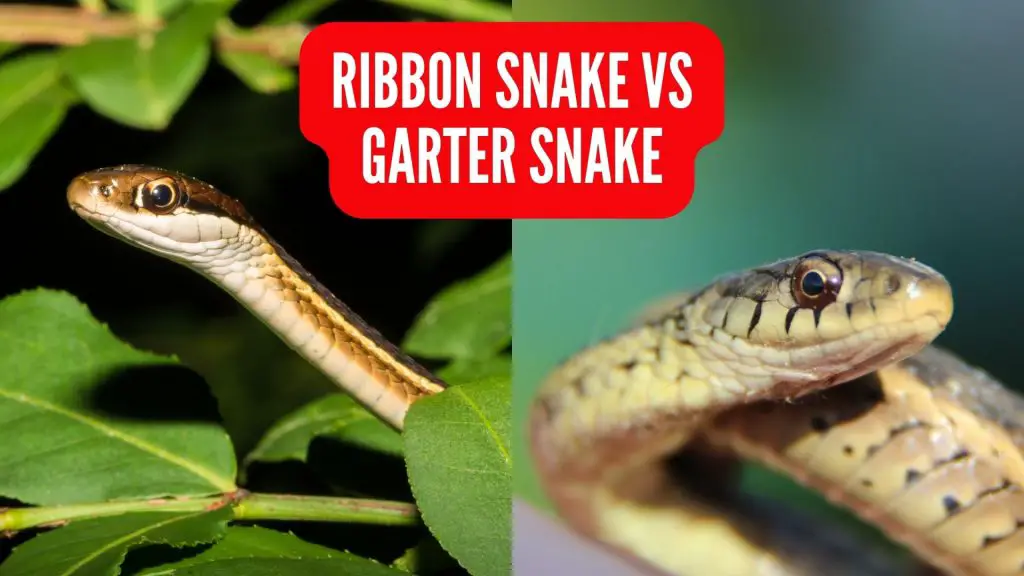At first glance, these snakes look similar. But if we take a closer look at Ribbon Snake vs Garter Snake appearance and habitats we find some significant differences…
Last updated on February 1st, 2023 at 09:25 am
Ribbon Snakes and Garter Snakes are both Natricinae colubrids in the Thamnophis genus. This means their overall appearance is very similar: they’re both slender and stripey. If you examine them closely, however, you will notice that Ribbon Snakes are thinner and have a proportionally longer tail. They also have a white patch right in front of each eye.
In this article, we’ll look at these differences, but also how they differ in habitat preferences so that you can become a Ribbon Snake vs Garter Snake identification expert.
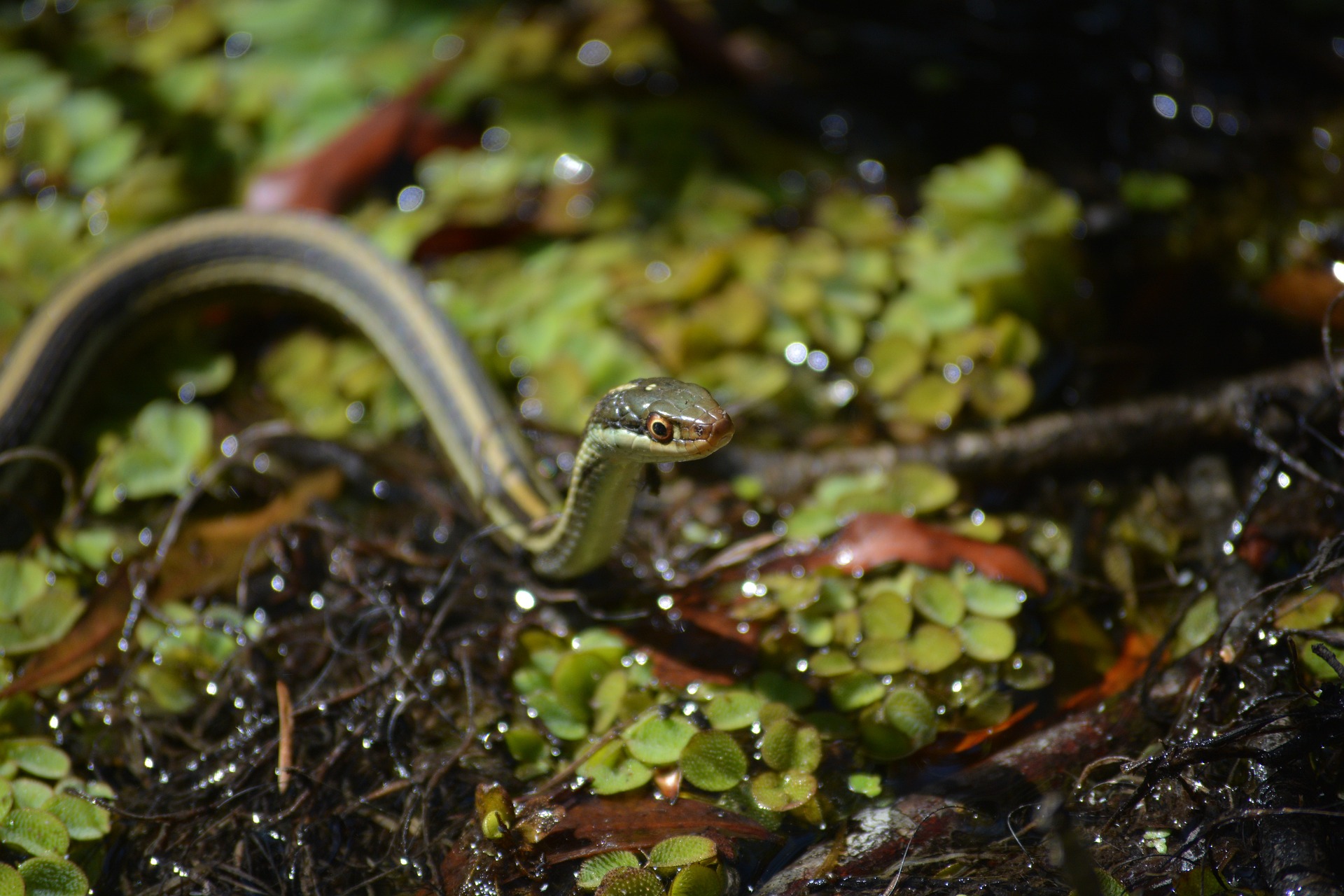
What are Ribbon and Garter Snakes?
Ribbon and Garter Snakes are part of the genus Thamnophis. This group of snakes is found throughout North America, but are most numerous in the eastern US. Most species love water, and many of them are semi-aquatic. They are almost exclusively diurnal and all but a couple of species have the characteristic yellow stripes on their backs.
Outside of North America, they are commonly kept as pets, and are often considered to be some of the best small snakes for pets.
Their scientific classification is as follows:
| Class: | Reptilia |
| Order: | Squamata |
| Suborder: | Serpentes |
| Family: | Colubridae |
| Subfamily: | Natricinae |
| Genus: | Thamnophis – contains all Ribbon and Garter Snake species |
Ribbon Snakes
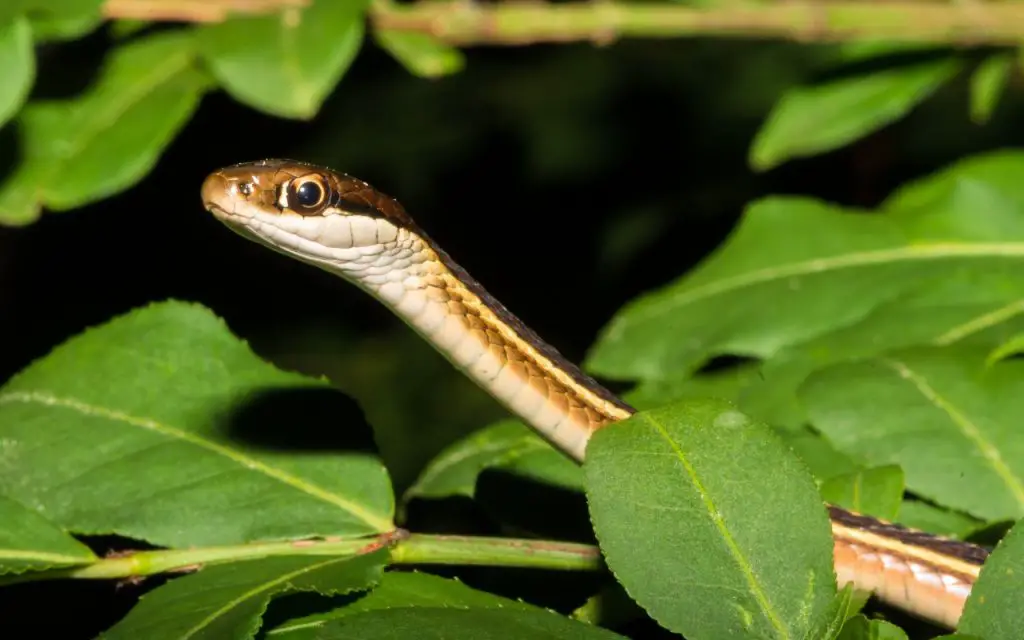
The Ribbon Snakes are close relatives of Garter Snakes, and are widely distributed accross North America.
The average length of a ribbon snake is between 15 and 30 inches (including the tail). They have three brilliant yellow stripes on a dark brown background. Their chins are white, and their bellies are whitish-yellow.
They are ovoviviparous and have live babies once or twice a year. Litters of 4-27 snakelets are typically born in the summer.
They are precocial (fully formed) at birth and are not cared for by their parents. They grow quickly and mature after 2-3 years of age, at which point they can begin breeding.
Regarding the eating method, ribbon snake overpowers their prey by simply grabbing it and consuming it rapidly. It mainly preys on frogs, salamanders, and freshwater fishes.
Garter Snakes
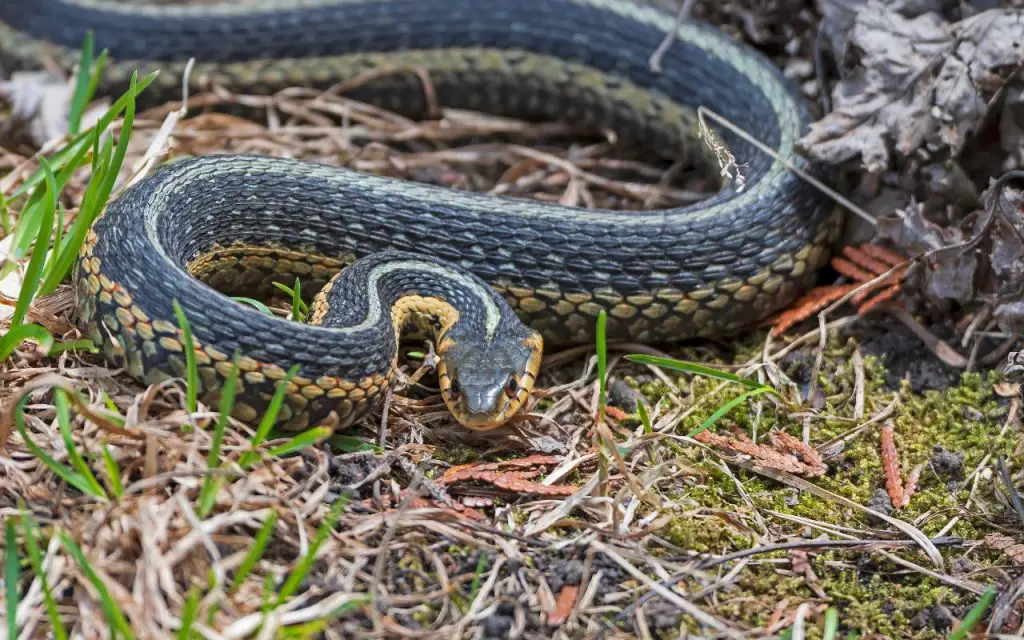
The garter snake is a common name for small to medium-sized snakes of the genus Thamnophis, which also belongs to the Colubridae family. These snakes are exceptionally hardy, living as far north as Ontario and at high altitudes out west (like the Sierra Garter around lake Tahoe).
Garter snakes vary in size and color depending on the species, but the majority have three longitudinal stripes, 1 in the center of the back and 1 on each lower side of the body.
They are typically less than 30 inches in length and are fairly harmless. Many of them wriggle around and musk when captured, rather than bite.
Garter snakes, like eastern ribbon snakes, have live births. Females often have 15-40 babies. After being born, they are left to hunt on their own.
Compared to ribbon snakes, garter snakes are more likely to eat slugs, worms, snails, leeches, and other organisms.
The 4 major differences between them
1. Body Shape
The first major difference between a ribbon snake and garter snake is the body shape. Ribbon Snakes have a slender body structure with 1 lateral stripe on each side of the body.
Also, it has one central stripe and a very long tail that accounts for almost 40% of the total body length.
On the other hand, the garter snake has a greyish-colored, thick body with or without stripes, but it is distinguished by its irregular black, red and white markings that are apparent on the skin between its dorsal scales.
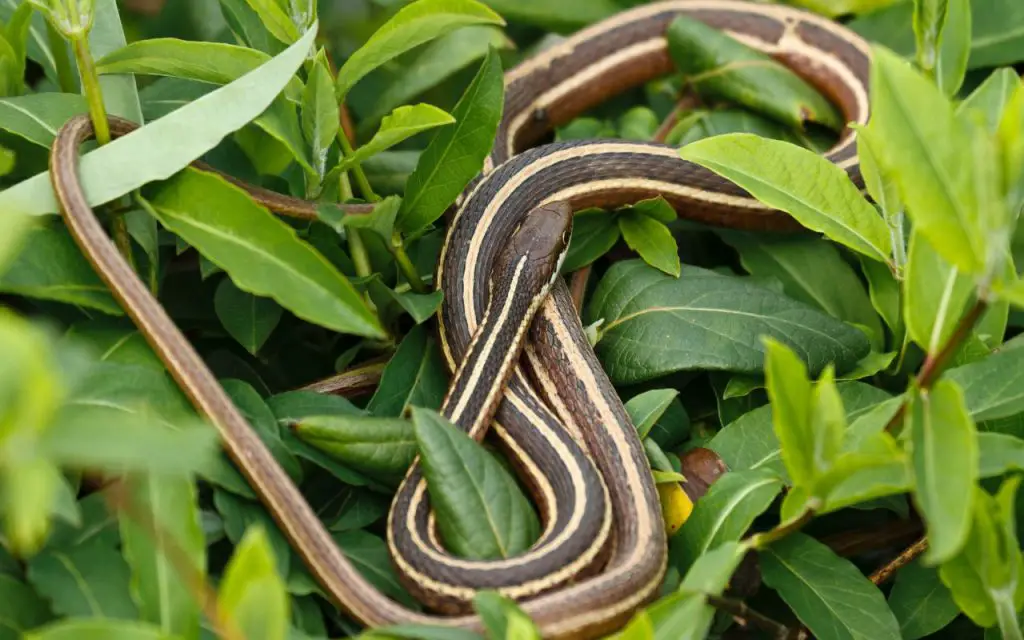
2. Tail Length
Garter Snakes always have shorter tails than Ribbon Snakes. They also tend to have thicker tails.
Some Garter snakes are infected with a parasitic worm (a type of nematode) that dwells in the tissues of their tail. Snakes with this ailment frequently have stubby or shortened tails.
Ribbon snakes, on the other hand, have longer tails than garter snakes. Their tails grow quickly and disproportionately, accounting for one-third of their body length.
3. Labial (lip) markings
Ribbon snakes lack black patterns between their lip scales (labial). They have pure white lips, and these white lips can be seen from a distance.
Dark markings run around the borders of each labial scale on Garter Snakes, and due to the dark patterns between the scales, each scale stands out.
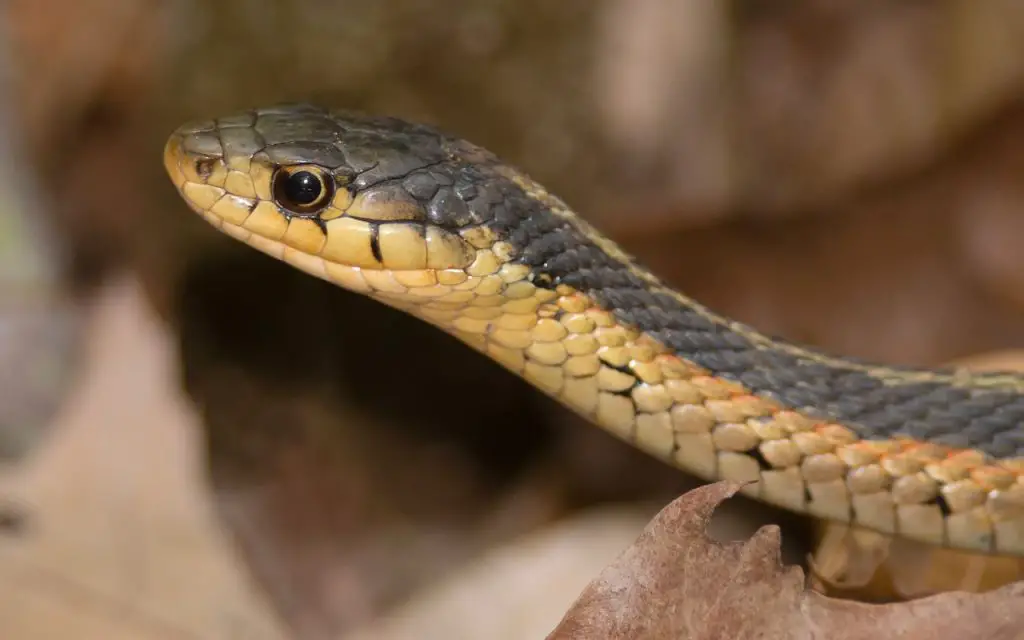
4. Eye markings
Ribbon snakes have huge, black eyes that are prominent. They have prominent white spots in front of each eye, which helps differentiate them from Garter Snakes.
Garter Snakes have huge round pupils and wide round eyes. There are no vertical white bars in front of their eyes.
5. Habitat preference
The garter snake’s success can be attributed to its opportunistic approach to habitat use and dietary preferences. They are mostly found in the Southeast of the United States, though they can be found all the way to the Pacific coast of California.
The garter snake lives in various habitats, including hardwood hammocks, forest borders, and pastures. They’ve also been spotted sunbathing on wood piles and stone walls.
Ribbon Snakes occupy a similar range in the United States, but they like shallow water to forage in. This limits them to areas such as:
- grassy meadows near ponds
- streams
- oxbow lakes
- slow-moving rivers
- marshland
- forested swamps
They are superb swimmers and spend most of their time outside during the day. Their swimming abilities allow them to escape predators by taking to the water.
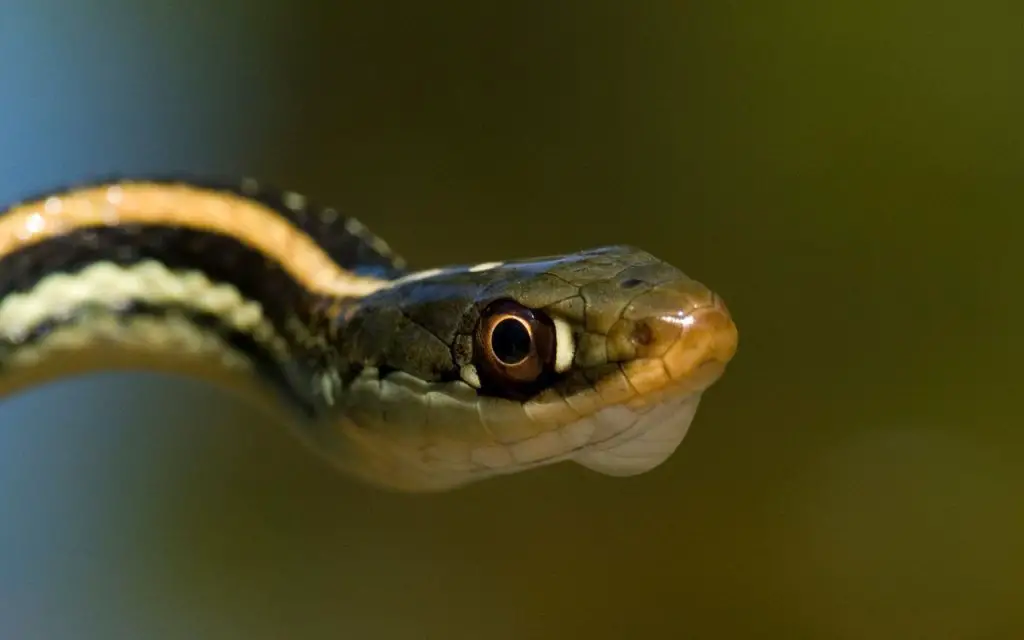
Summary table of differences
| Attributes | Ribbon Snake | Garter Snake |
| Body Shape | very slender | medium build |
| Tail length | over 30% of total length | under 30% of total length |
| Labial markings | none | black on edges of labial scales |
| Eye markings | white spots in front of eyes | none |
| Habitat preference | marshland, ponds, streams | almost anywhere |
Lined snake vs garter snake
Another stripey snake that looks a lot like Garter Snakes and Ribbon Snakes is the Lined Snake (Tropidoclonion lineatum). Unsurprisingly, it is fairly closely related to them, despite being in a separate genus.
Lined snakes resemble both the plains garter snake and the common garter snake but can be differentiated by the appearance of half-moon markings on the underside.
They are typically small, with adults ranging from 8 to 12 inches in length, whereas an adult garter snake averages 15 to 30 inches. Lined snakes are dark to greyish-brown in color, with the color ranging from greyish-brown to dark grey to olive grey stripes.
Garter snakes, on the other hand, have a black, greenish-brown, tan, or grey background with 1 stripe going down the middle of the back.
The belly is white, with two rows of dark grey dots or half-moon shapes running through the center.
Garter snake chin, throat, and belly are colored similarly to stripes, ranging from greenish, blue, and white to yellow or brown. Lined Snakes tend to be duller overall, and are often overwhelmingly gray in color.
The lined snake is semifossorial and spends most of its life concealed beneath rocks, leaf litter, logs, or in the soil. Their natural habitat is grassland with soft, damp soil.
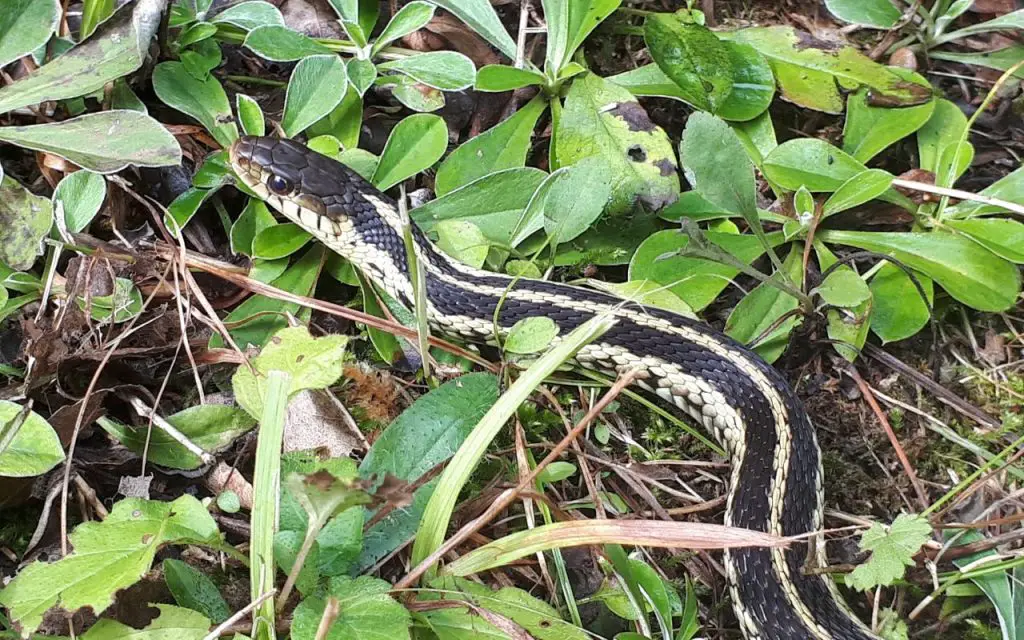
FAQ relating to Ribbon Snake Vs Garter Snake
Is a ribbon snake a garter?
Ribbon Snakes are semi-aquatic American snakes that belong to the genus Thamnophis but are not Garter Snakes. They prefer river and pond edges and marshes because they are excellent swimmers. This excellent swimming ability aids them in evading predators.
On the other hand, Garter snakes are more terrestrial and can be found in fields and wetlands. Furthermore, garters appear to be more resilient and responsive to environmental changes than ribbons.
Finally, in terms of reproduction, both snakes give birth to live babies, but their mating periods may differ. Both snakes begin mating after emerging from hibernation- the ribbon snake may also mate in the fall.
Is a ribbon snake poisonous?
Ribbon snakes are not dangerous or poisonous (or venomous, which is the correct term). They are an inoffensive snake that rarely exhibits violent behavior in self-defense.
These docile snakes are not dangerous to humans or pets and rarely bite if they come into direct contact with them. They move quickly and hide in thickets, marshlands, and around ponds.
If they are captured or pinned, they will thrash around and emit a foul-smelling musk from their set of glands at the base of their tail.

Are ribbon snakes bigger than garter snakes?
Garter snakes and ribbon snakes are roughly the same sizes, measuring from 15-30 inches long. Each has a dark body with three light-colored stripes running through the body’s length.
Between the light stripes, garter snakes frequently have a checkered pattern. Ribbon snakes have smaller heads and are thinner and sleeker in appearance.
The main difference in size and length between the two snakes is that ribbon snakes are beautifully slender, whilst garter snakes have a more rounded and thick body. Furthermore, the ribbon snake’s tail length is greater than that of the garter snake, giving the impression that it is larger in length.
How do you identify a ribbon snake?
- Ribbon snakes are thin snakes that grow to be 15-30 inches long. They have three light stripes, usually yellow, against a dark background.
- Their tail is one-third the length of their body, and each of their eyes has a white tear-drop scale.
- In addition, the typical ribbon snake has two distinct parietal “spots” on top of its head, which is unique to ribbon snakes.
- They are typically found near the edges of lakes, bogs, and marshes.
- The ribbon snake is active from April to October, hibernates during the winter, and matures at roughly three years of age.

Can you handle a ribbon snake?
The eastern ribbon snake is readily tamed, enjoys attention, and can be picked up and handled without concern of agitating or inciting a bite. The main aspect to keep in mind is that the snake should not feel captured or pinned.
When ribbon snakes are caught and pinned, they become fearful and dislike being handled, which may cause them to bite you.
However, you should not be terrified of their bite because they are non-venomous.
Do ribbon snakes bite humans?
Ribbon snakes are usually quite shy and do not threaten humans. However, you should not mishandle them. As previously said, they will bite if they feel threatened or mistreated. It will scratch a little, but it will do any real damage.
If you are bitten, clean the wound thoroughly with soap and water, as you do with any bite. Their strength is speed- if they feel attacked, their initial reaction will be to flee.
It is not considered dangerous to people and does not bite unless provoked. Even if you come across a wild snake, you should always leave it alone.

